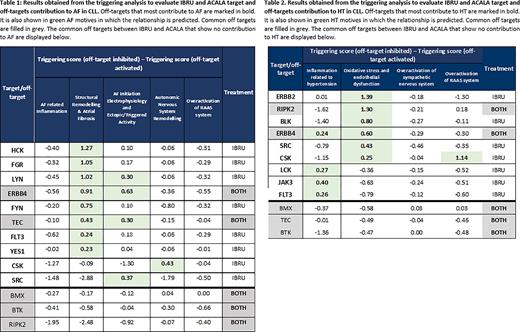Abstract
Introduction: Ibrutinib (IBRU) and acalabrutinib (ACALA) are first and second generation Bruton Tyrosine Kinase inhibitors (BTKi), respectively, approved for the treatment of chronic lymphocytic leukemia (CLL). Beside the main target, BTKis may inhibit other tyrosine kinases leading to unfavorable off-target effects. The introduction of second generation BTKis was based on their potential of greater selectivity and affinity for BTK inhibition and therefore fewer off-target side effects. Despite many survival benefits, IBRU is associated with adverse events probably due to the off-target inhibition; of concerns are the cardiovascular events. The second-generation BTKi ACALA is more selective to BTK and with less off-target inhibition. A randomized phase III trial comparing ACALA and IBRU in CLL patients demonstrated non-inferior progression free survival with ACALA, along with fewer cardiovascular events, such as atrial fibrillation (AF) and hypertension (HT). Here we present a systems biology- and artificial intelligence-based in silico study to infer the likely pharmacological mechanisms that underlie AF and HT induced by these drugs.
Methods: Therapeutic Performance Mapping System (TPMS) technology (Anaxomics Biotech, Spain) was used to create mechanistic models of ACALA and IBRU at the protein interactome level. First, published evidence was reviewed and compiled to molecularly characterize CLL, AF, HT and the target profile of these drugs. Then, supervised machine learning algorithms were applied to computationally infer AF and HT mechanisms. Model-derived measures were used to rank the targets more likely to trigger AF and HT. Finally, the potential mechanisms of action of inhibiting these targets were identified. Although the models are protein-based, the interactome in which they are build include gene and RNA regulation data; for standardization purposes, gene names are used for genes/proteins mentioned in this abstract.
Results: The results show that BTK inhibition is not the only factor contributing to AF and HT induction, as they could be mediated by other off-targets impacting pathophysiological processes (Tables 1 and 2). Regarding AF, potential off-target mechanism of action is the inhibition of TEC and ERBB4, which can downregulate PIK3CA and NOS3 involved in atrial fibrosis and downregulate ZFHX3 and the sodium channels SCN1B and SCN5A having an impact in electrophysiology regulation. While no ACALA-specific AF off-targets were identified, IBRU data showed specific off-targets potentially involved in AF mechanisms such as structural remodeling and atrial fibrosis (HCK, FGR, LYN, FYN, YES1 and FLT3), electrophysiology regulation (LYN and SRC), and autonomic nervous system remodeling (CSK). Regarding HT, potential off-target mechanism of action is the inhibition of RIPK2 and ERBB4, which can trigger HT through the following common pathways: modulation of pro- and anti-inflammatory cytokines (IL6, IL10 and TNFA), induction of oxidative stress (NOS3), and endothelial dysfunction (MME, ROCK1, ROCK2, VEGFA and VEGFD). No ACALA-specific HT off-targets or mechanisms were detected, while seven IBRU-specific off-targets were involved in inflammation related to HT (LCK, JAK3 and FLT3) and oxidative stress and endothelial dysfunction (ERBB2, BLK, SRC and CSK).
Conclusions: BTKi selectivity is key for CLL disease control and BTK inhibition is not the only factor for AF and HT. This analysis supports that BTKi-induced AF and HT are off-target effects that can partly be mediated by TEC and ERBB4, and RIPK2 and ERBB4 inhibition, respectively. However, other IBRU-specific off-targets and mechanisms could also explain its association with the higher incidence of AF and HT. Although potential literature bias and inhibition potency should be considered in prospective studies, our findings are a starting point to understand ACALA and IBRU differences regarding AF and HT incidence in CLL patients.
Study and medical writing support were funded by AstraZeneca.
Disclosures
Cordoba:Astra Zeneca: Consultancy; Janssen: Consultancy; Beigene: Consultancy; Lilly: Consultancy; Astra Zeneca: Other: Speaker; Janssen: Other: Speaker. Colomer:AstraZeneca: Consultancy; Annie Pharma: Consultancy. Leiva Farre:AstraZeneca: Current Employment. Álvarez:AstraZeneca: Current Employment. López:AstraZeneca: Current Employment. Zatarain:Bayer: Other: Experts pannel, academic activities; AstraZeneca: Other: Experts pannel, academic activities; Almirall: Other: Experts pannel, academic activities; Novartis: Other: Experts pannel, academic activities.
Author notes
Asterisk with author names denotes non-ASH members.


This feature is available to Subscribers Only
Sign In or Create an Account Close Modal